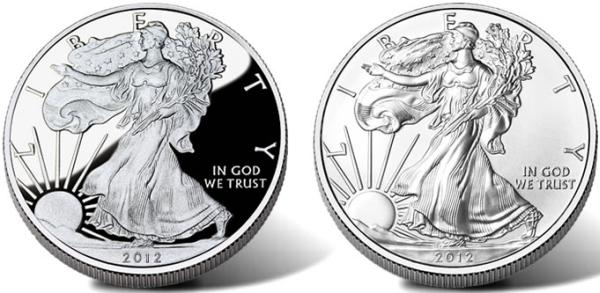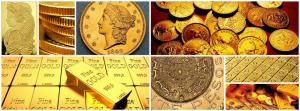Proof Coin Production
Whereas most buyers of gold coins or other precious metal coins prefer to buy brilliant uncirculated coins as they can be bought for prices close to the spot price of the metal, many numismatic collectors prefer to buy proof coins. Coins with a proof finish undoubtedly represent the highest quality level in the production of coins. So what makes proof coin production different from the production of brilliant uncirculated coins?

Proof coin production requires special steps and extra care to create such a perfect finish like on the Silver Eagle on the left
The first big difference in proof coin production is that all the dies that are used to strike proof coins are hand-finished. After the design of the die has been created with a mirror-like background and the frosted artwork, the die is protected from damage by the PVD (Physical Vapor Disposition) process. It produces a coating with a hard layer of chrome on the die’s surface. Each proof die is then manually checked for the slightest of imperfections that are then removed. After striking a number of only a few hundred coins, the proof dies are also reworked and repolished.
Treatment of Coin Blanks in Proof Coin Production
Secondly, only the best coin blanks will be selected to become proof coins. Before the coin blanks are struck though, they are fed into an annealing furnace which softens up the metal. Without this step, the blanks would be too brittle to withstand the pressure of the striking process without damage. The rimming process is next, which moves some of the metal to the outer edge to form a solid border there. Some oxides may form on the blank surface during these two steps. These are cleaned off in the burnishing process which follows next. In a burnishing mill, the coin blanks are mixed around at high speed in a container with metal pellets and some cleaning and anti-tarnishing chemicals. That process polishes up the blanks and evens out their surface.
For the stamping process in proof coin production, each proof blank will be placed into the coin press by hand. The press will then strike each proof blank up to six times with a lower speed and pressure than the other types of coins. As a result, the design of the coin will appear more precisely defined and with smoother clear surfaces.
After the striking process is complete, the proof coin will be removed from the coin press by hand and carefully checked for imperfections. Before the next proof coin will be inserted to be struck, the dies will be cleaned by air. That ensures that no material residue, no matter how small, remains stuck to the die as that could cause marks on the next coin. Because of the fastidious process that is required to strike proof coins of the highest quality, no more than 50 such coins can be struck in an hour. During the same time period, about 3,000 bullion coins could be struck.



Nothing satisfies the eyes more than a Proof Gold Buffalo..